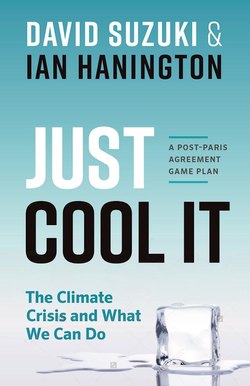Читать книгу Just Cool It! - David Suzuki - Страница 11
На сайте Литреса книга снята с продажи.
ОглавлениеChapter 3
OBSTACLES AND BARRIERS
AS WE SAW with the 2015 UN Climate Conference and subsequent Paris Agreement, experts and world leaders are taking the issue of global warming seriously. Although some may quibble over details around exact causes, effects, and implications, very few legitimate scientists and researchers deny that human activity is a major contributor to global warming. No peer-reviewed scientific study has overturned the prevailing theory of climate change. Scientific research has also found conclusive evidence for the causes, which include burning fossil fuels, damaging or destroying forests and other green spaces, and employing energy-intensive and methane-producing agricultural practices that contribute to rising emissions. Although the science of global warming and all its related phenomena—from feedback cycles to impacts on oceans, land, ice, and snow; animal migration patterns; and more—are incredibly complex, the major causes are not, and so the solutions are not as complicated as they seem. We know that to address the problem we must conserve energy and find cleaner ways of obtaining energy than burning fossil fuels, and we must protect and preserve the natural systems that absorb and store carbon, such as oceans and forests. And although excessive consumption in the developed world contributes as much or more to climate change than population growth in the developing world, stabilizing population growth must also be part of the solution. The best way to achieve that is by giving women greater rights worldwide, especially regarding access to birth control and family planning education, as well as the right to participate in society and political decision-making.
If we agree there’s a problem and we know what to do about it, why are we still pursuing activities that contribute to it? Why aren’t people around the world doing more to slow or halt global warming? The 2015 Paris Agreement was a start, but even it doesn’t put us on track to achieve the level of emissions reductions needed to avert disaster. A big part of the problem is that, for many reasons, we’ve failed to do enough for so long that it has become more difficult than ever to resolve what has become a global crisis. We’ve developed massive infrastructure for a fossil-fueled world, especially in industrialized nations. Fossil fuels have made possible much of our prosperity, technological advances, breakthroughs in agricultural methods and scientific developments, and increasingly convenient lifestyles. It’s not that easy to retool or quickly shift direction when fossil fuels have become such an integral part of human existence. Fossil fuels have also, in part, driven the world’s population boom. And as poorer nations with large and often rapidly growing populations come to expect the same benefits people in the industrialized world have enjoyed, they look to inexpensive and relatively easily obtained fossil fuels to help them catch up.
Politicians and the systems they operate within are geared more toward short-term than long-term planning. Immediate economic prosperity keeps people happier and, in democracies, wins more votes than long-term planning that might include sacrifices. And a country like China, the world’s largest greenhouse gas emitter, has a political system that allows it to say one thing and do another, with few ways for its people or the rest of the world to know what it’s actually doing in terms of increasing or reducing its contribution to climate change.
The fossil fuel industry, which is by far the most profitable industry in the history of humanity, has also spent enormous amounts of time and money to protect its interests. That has involved political lobbying, paying massive amounts of cash to politicians and political parties to further its interests, campaigning to sow doubt and confusion about global warming and its consequences—often through front groups with scientific-sounding names or bogus studies—and developing infrastructure that locks societies into fossil fuel use.
This chapter will examine some of the barriers to resolving the climate crisis, including many of the arguments used to downplay the problem and its severity.
The China Syndrome
THOSE WHO REJECT the evidence for anthropogenic climate change throw many slippery arguments onto the path of progress. Most of them are irrational, easily debunked, or disingenuous, but one contains a germ of truth. “Unless China and India stop emitting such high levels of greenhouse gases, nothing other countries do will make a difference,” they claim. It’s used as an argument against taking action on climate change, the assumption being that China and India will continue to increase emissions as their populations grow and industrialization expands.
Every nation, no matter how great or small its contribution to global warming, must do its part to resolve the problem, regardless of what other nations may or may not do. Arguing that we should give up because others aren’t doing their part is an immature and facile argument. But it’s true that if China and India refuse to do their part, we’re pretty much screwed.
China is the largest greenhouse gas emitter, accounting for one-fifth or more of the world’s energy consumption and close to one-quarter of emissions—and its energy use is steadily increasing. What it does or doesn’t do to combat climate change will make a big difference in global efforts. (Although India is a large and heavily populated country with the world’s fastest-growing economy, it is the fourth-largest greenhouse gas emitter, behind China, the U.S., and the European Union, in part because its per capita emissions are much lower than in the U.S., China, the EU, and many other countries.)
